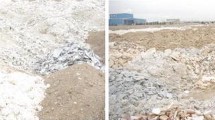Abstract
In the present work, the mixing process of different components of abrasive stones of cubic boron nitride used for rough honing was studied. Stones are made by the sintering process of abrasive grains, a metallic bond, and a humectant that favors covering of each abrasive grain by the bond. Incorrect mixing of abrasive grains with the bond and humectant can result in stones with nonuniform abrasive grain distribution. As the abrasive stone wears out, grain distribution will vary and modify efficiency of the honing operation. Tin is the metal having the lowest melting point among metals in the bond. By means of a scanning electron microscope and energy-dispersive X-ray microanalysis, tin segregation was discarded, which could have led to abrasive grain segregation. Later, mixing tests of the different components of the stones were performed at different mixing times. Both homogeneity degree of the abrasive content of different samples in a mix and covering degree of abrasive grains by bond were determined through two new parameters introduced in the present study. It was noted that use of a chain to accelerate the mixing process excessively reduces covering degree of abrasive grains even at initial mixing times. The highest quantity of humectant is recommended in order to get better covering degree. Mixing time should be high enough to assure homogeneity degree of the mix but low enough to avoid excessive reduction of covering degree.
Similar content being viewed by others
References
Webster J, Tricard M (2004) Innovations in abrasive products for precision grinding. CIRP Ann-Manuf Techn 53(2):597–617
Burkhard G, Rehsteiner F, Schumacher B (2002) High efficiency abrasive tool for honing. CIRP Ann-Manuf Techn 51(1):271–274
Ding WF, Xu JH, Lu JB, Fu YC, Xiao B, Xu HJ (2004) Brazed CBN gringing wheel with Ag-base filler alloy. Mater Sci Forum 471–472:11–5
Naidich YV, Zhuravlev VS, Gab II, Kostyuk BD, Krasovskyy VP, Adamovskyy AA, Taranets NY (2008) Liquid metal wettability and advanced ceramic brazing. J Eur Ceram Soc 28(4):717–728
Tiefenbach LW (1990) Method of preparing abrasive articles. US4, 918, 874
Fruitman CO (1999) Grinding composition using abrasive particles on bubbles. US4, 918, 874
Bonner AM, Bright E, Lambert EL, Matsumoto DS, Orlhae X, Sheldon DA (2008) Abrasive articles with novel structures and methods for grinding. US2008/0066387 A1
Elsener HR, Klotz UE, Khalid FA, Piazza D, Kiser M (2005) The role of binder content on microstructure and properties of a Cu-base active brazing filler metal for diamond and CBN. Adv Eng Mater 7(5):375–380
Querel G, Dando PS, Jousseaume C, Hall RW (2008) Bonded abrasive article and method of making. US7, 935, 158
Rolander U, Weinl G (2001) Method for making a sintered composite body. US6, 287, 489B1
Fan LT, Chen SJ, Watson CA (1970) Solids mixing. Ind Eng Chem 62:53–69
Kaye BH (1997) Powder mixing. Chapman & Hall, London
Lemieux M, Bertrand F, Chaouki J, Gosselin P (2007) Comparative study of the mixing of free-flowing particles in a V-blender and a bin-blender. Chem Eng Sci 62(6):1783–1802
FEPA (1997) 61/97—FEPA standard for superabrasives grain sizes
Ding WF, Xu JH, Shen M, Fu YC, Xiao B, Su HH, Xu HJ (2007) Development and performance of monolayer brazed CBN grinding tools. Int J Adv Manuf Technol 34:491–495
Author information
Authors and Affiliations
Corresponding author
Rights and permissions
About this article
Cite this article
Buj-Corral, I., Vivancos-Calvet, J. Improvement of the manufacturing process of abrasive stones for honing. Int J Adv Manuf Technol 68, 2517–2523 (2013). https://doi.org/10.1007/s00170-013-4854-8
Received:
Accepted:
Published:
Issue Date:
DOI: https://doi.org/10.1007/s00170-013-4854-8




